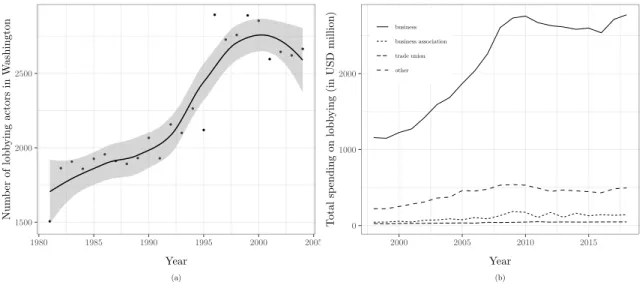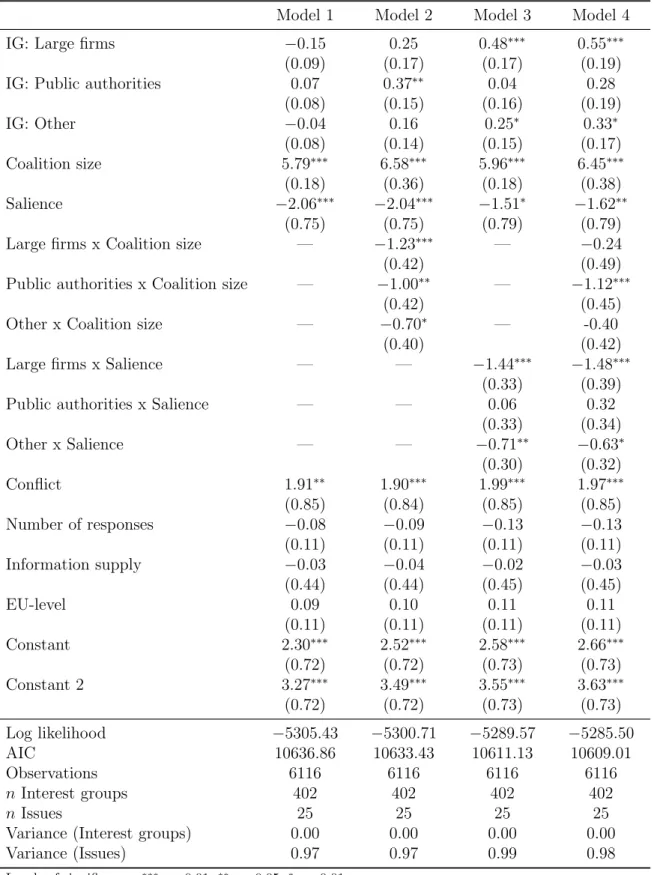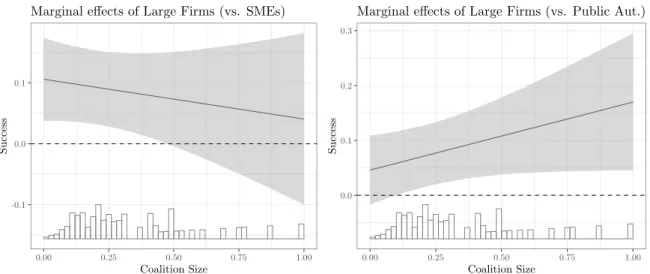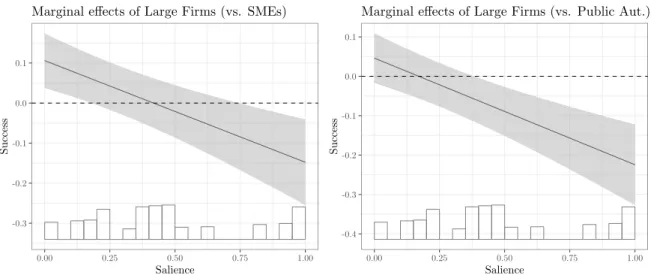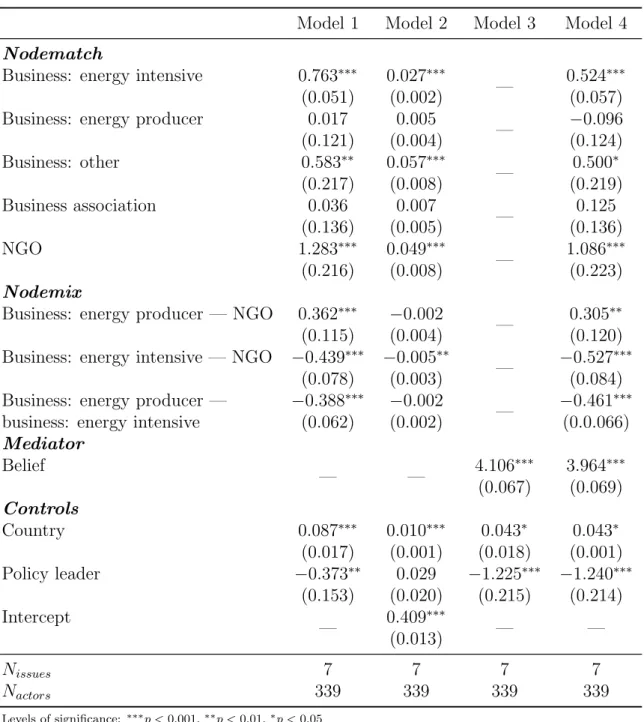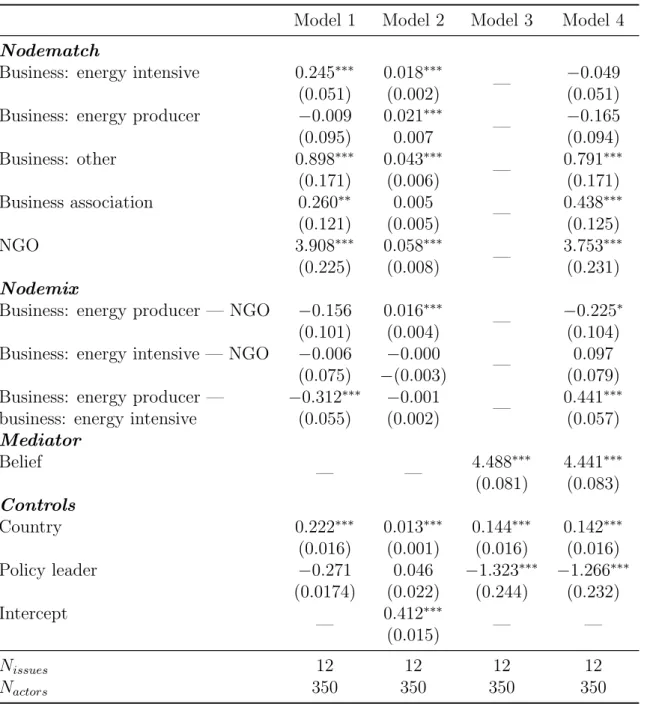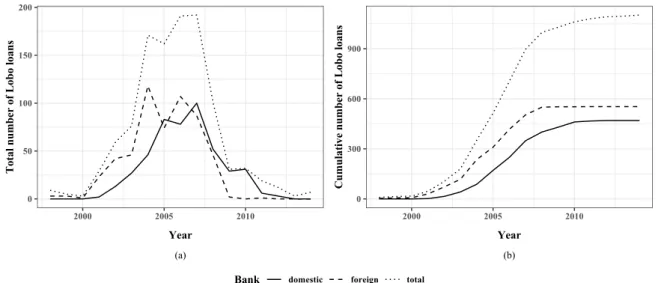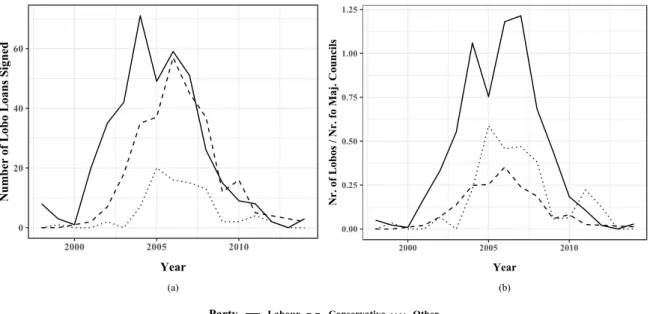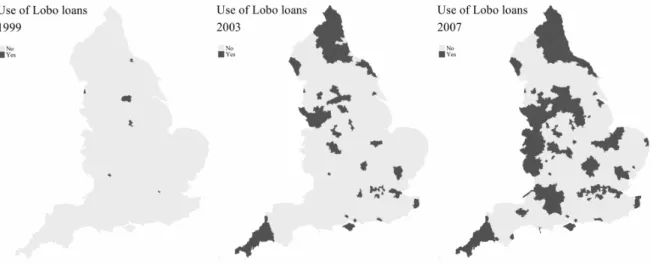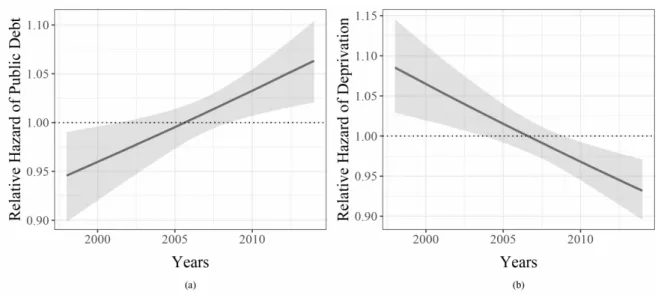Business Power in European Politics
Inauguraldissertation zur
Erlangung des Doktorgrades der
Wirtschafts- und Sozialwissenschaftlichen Fakult¨at der
Universit¨at zu K¨oln
2019
vorgelegt von
Armin Mertens, M.A.
aus
Bergisch Gladbach
Referentin: Prof. Dr. Christine Trampusch Korreferent: Prof. Dr. Andr´e Kaiser
Tag der Promotion:
ACKNOWLEDGEMENTS
This is dissertation is the result of three years of work at the Cologne Graduate School in Management, Economics and Social Sciences (CGS) and the Cologne Center for Comparative Politics (CCCP) at the University of Cologne. The process of writing this thesis has been both very rewarding and, at times, very challenging and I would not have been able to complete it without the love and support of many people I had the privilege to meet.
First and foremost, I would like to thank my supervisor Christine Trampusch. Not only did she believe in my abilities and allowed me to start writing this thesis in the first place, but she also provided indispensable guidance and encouragement along the way.
Especially in the early stages of my work, her confidence and structured support were an invaluable resource. As the academic world is full of obstacles and intricacies, I would wholeheartedly like to thank Christine Trampusch for helping me to figure those out.
Next, I am also very grateful to my second supervisor, Andr´e Kaiser, for his support and trust. Not only was I the beneficiary of his extremely helpful comments in the weekly research seminar but I also had the pleasure to receive very encouraging words on one of the infamous CCCP Christmas parties. After struggling a lot during the first months of my doctorate, his expertise and reassurance to keep going strengthened my motivation in the time to follow. Moreover, I would like to acknowledge the financial support of the CGS without which this dissertation would not have been possible.
I am also extremely grateful for the large number of intelligent, educated and creative
colleagues at the CCCP. Their advice and friendship have contributed immensely to
my personal and professional time in Cologne. Especially in the beginning, I am very
lucky to have had the possibility to frequent the offices of Florian Fastenrath, Michael
Schwan and Dennis Spies. Their experience, empathy and above all their helpfulness
were invaluable at the time. The same can be said about all other members of the Chair
for International Comparative Political Economy and Economic Sociology. Philip Gros,
Leon Kanthak and Dennis Abel were amazing colleagues who were irreplaceable both
in direct collaboration as well as intellectual skirmishes. As I was always interested
in methodological challenges and statistical concepts and algorithms, I am extremely
happy to have made the acquaintance of Felix Bethke and Holger Reinermann. Both
spared no expense or e↵ort in explaining even the most complicated matters to me
and have always been willing to discuss statistical problems at a very high level. For
amazing comments and feedback on the papers comprised in this doctoral thesis, I
would also like to thank (next to all of the above-mentioned people) Paul Beckmann, Lea Kaftan, Daniel Saldivia Gonzatti and Sven-Oliver Proksch.
I also had the pleasure to engage in inspiring and successful collaborations. First, I would (again) like to thank Christine Trampusch and Florian Fastenrath but also Rebecca Wangemann for tackling even the most daunting problems and intricacies of English local government financialisation. Next, Dennis Abel has been an outstanding comrade in arms in diving into the complex worlds of natural language processing, network science, and (sometimes) obscure theoretical constructs. I also learned a lot from my joint work with Ayjeren Rozyjumayeva, Franziska Pradel and Jens W¨ackerle, all of whom were amazing colleagues. Last but not least, I thoroughly enjoyed my (mostly non-academic) collaboration with Dennis Abel, Daniel Saldivia Gonzatti and Leonce R¨oth at the ping-pong table. All of you were worthy competitors and I hope we play again in the foreseeable future. In no particular order, I would also like to thank Jan Schwalbach, Kristina Ophey, Jan Sauermann, Agnes Janssen and Franziska Deeg, as well as all other colleagues who made my time at the CCCP an invaluable experience and Julian Lehman as well as Marius Vogel from the CGS cohort of 2016, who were great office neighbours and friends during my time at the University of Cologne.
Besides my colleagues at work, I am particularly blessed with amazing friends that continually supported me throughout the process of writing this thesis. First and foremost, I want to thank Nenia, who I am incredibly lucky and privileged to be in a relationship with. Her loving support, intellectual wit, and knowledge of my peculiarities not only made the last three years some of the best years of my life, but also made this dissertation possible in the first place. I also want to thank my parents for reading to me when I was little and for fostering my intellectual curiosity.
Ultimately, I want to thank all my friends who were and still are great to spend time with. Keeping my mind of this thesis was both very difficult but also, at times, very necessary and having amazing friends around was a great way of keeping me busy outside of work and having a good time.
Armin Mertens
University of Cologne
November 2019
CONTENTS
1 Introduction 1
1.1 Business Power and the State . . . . 5
1.1.1 Defining Business Power . . . . 5
1.1.2 The Structural and Instrumental Power of Business . . . . 7
1.1.3 The Influence of Lobbying on Policy-Making . . . . 10
1.1.4 Conceptualising Power in Policy Networks . . . . 16
1.2 Methodological Approaches . . . . 17
1.3 Overview of the Included Studies . . . . 19
1.3.1 Chapter 2 . . . . 19
1.3.2 Chapter 3 . . . . 21
1.3.3 Chapter 4 . . . . 22
1.4 Relevance and Broader Implications . . . . 24
1.5 Publication Status of the Articles . . . . 27
2 Regulating the Audit Market in the European Union: Who Domi- nates, Who Loses? 29 2.1 Introduction . . . . 30
2.2 The EU Audit Market Regulation . . . . 31
2.3 Interest Group Preference Attainment: Who Prevails and Why? . . 33
2.4 Data and Methods . . . . 36
2.4.1 Case Selection . . . . 36
2.4.2 Measuring Success . . . . 37
2.4.3 Independent and Control Variables . . . . 38
2.5 Results . . . . 39
2.5.1 Descriptive Results . . . . 39
2.5.2 Multivariable Analysis . . . . 40
2.5.3 Robustness Checks . . . . 44
2.6 Discussion . . . . 45
3 United in Disagreement: Analysing Policy Networks in EU Policy- Making 47 3.1 Introduction . . . . 48
3.2 Policy Networks and Shared Belief Systems . . . . 50
3.2.1 Belief Homophily and Ally Networks . . . . 52
3.2.2 Ally Networks Between Strange Bedfellows . . . . 53
3.3 The EU ETS and Carbon Leakage . . . . 55
3.4 Estimation Strategy . . . . 57
3.4.1 Modelling Ally Networks . . . . 57
3.4.2 Data . . . . 60
3.5 Analysis . . . . 63
3.5.1 Results . . . . 63
3.5.2 Discussion . . . . 67
3.6 Conclusion . . . . 70
4 The Political Economy of Local Government Financialisation and the Role of Policy Di↵usion 73 4.1 Introduction . . . . 74
4.2 The Structure and Use of Lobo Loans . . . . 76
4.3 The Financialisation of Local Governments . . . . 78
4.3.1 Partisan Politics . . . . 78
4.3.2 Fiscal and Economic Stress . . . . 79
4.3.3 Local Finance Power . . . . 81
4.3.4 The Di↵usion of Policies and Financial Innovations . . . . 82
4.4 Data and Method . . . . 84
4.4.1 Dependent Variable . . . . 84
4.4.2 Independent Variables . . . . 84
4.4.3 Control Variables . . . . 85
4.4.4 Method . . . . 86
4.5 Findings . . . . 87
4.5.1 Descriptive Statistics . . . . 87
4.6 Results and Discussion . . . . 89
4.7 Conclusion . . . . 94
5 Supplementary Material 99 SM1 Regulating the Audit Market in the European Union: Who Domi- nates, Who Loses? . . . . 99
SM1.1 Data Preparation . . . . 99
SM1.2 Summary Statistics . . . 101
SM1.3 Issue Description . . . 104
SM1.4 Additional Analyses . . . 106
SM2 United in Disagreement: Analysing Policy Networks in EU Policy- Making . . . 109
SM2.1 Model Diagnostics . . . 109
SM2.2 Model Specifications . . . 114
SM2.3 Survey Content . . . 115
SM2.4 Robustness Checks . . . 118
SM2.5 Statistical Software . . . 121
SM3 The Political Economy of Local Government Financialisation and the Role of Policy Di↵usion . . . 122
SM3.1 Descriptive Statistics . . . 122
SM3.2 Additional Models . . . 123
SM3.3 Correlation Matrix . . . 126
SM3.4 Organisation of Local Governments in England . . . 127
SM3.5 Expert Interviews . . . 128
SM3.6 Additional Literature and Data Sources . . . 129
SM3.7 Statistical Software . . . 130
Bibliography 131
LIST OF FIGURES
1.1 Lobbying in the European Union . . . . 3
1.2 Lobbying in the United States . . . . 4
2.1 Mean interest group preference by group type . . . . 40
2.2 Marginal e↵ects of large firms on success by coalition size . . . . 42
2.3 Marginal e↵ects of large firms on success by salience . . . . 43
3.1 Belief systems as mediators of ally network formation . . . . 53
3.2 Strange bedfellows and ally networks . . . . 54
3.3 Path models showing a total e↵ect of X on Y (above) and the me- diated e↵ect through M (below). . . . 60
4.1 Number of Lobo loans taken up by English local governments . . . 77
4.2 Number of Lobo loans signed by party in office (1998-2014) . . . . 88
4.3 The geographical di↵usion of Lobo loans across English municipali- ties (1999-2011) . . . . 89
4.4 Simulated relative hazards for the e↵ect of public debt and economic deprivation on the use of Lobo loans . . . . 91
4.5 Simulated marginal e↵ects of financial sector power on the use of Lobo loans . . . . 92
SM1.1 Distribution of all actors’ preferences by policy issue . . . 102
SM1.2 Distribution of submissions by interest group type and issue . . . . 103
SM2.3 Trace plots for AME Model 1 on issues with low potential for inter- group conflict shown in Table 3.1. . . 109
SM2.4 Trace plots for AME Model 2 on issues with low potential for inter- group conflict shown in Table 3.1. . . 110
SM2.5 Trace plots for AME Model 3 on issues with low potential for inter- group conflict shown in Table 3.1. . . 110
SM2.6 Trace plots for AME Model 4 on issues with low potential for inter- group conflict shown in Table 3.1. . . 111
SM2.7 Trace plots for AME Model 1 on issues with high potential for inter- group conflict shown in Table 3.2. . . 111
SM2.8 Trace plots for AME Model 2 on issues with high potential for inter-
group conflict shown in Table 3.2. . . 112
SM2.9 Trace plots for AME Model 3 on issues with high potential for inter- group conflict shown in Table 3.2. . . 112 SM2.10 Trace plots for AME Model 4 on issues with high potential for inter-
group conflict shown in Table 3.2. . . 113
LIST OF TABLES
2.1 Mixed-e↵ects ordered logistic regression models (base group: SME) 41 3.1 AME results for ally networks on policies with low potential for
inter-group conflict (standard errors in parentheses) . . . . 64
3.2 AME results for ally networks on policy issues with high potential for inter-group conflict (standard errors in parentheses) . . . . 65
4.1 Repeated event survival analysis (1998-2014) . . . . 90
SM1.1 Cleansing process of interest group submissions . . . . 99
SM1.2 Descriptive statistics . . . 101
SM1.3 Correlation matrix of main variables . . . 101
SM1.4 Correlation matrix of main variables (continued) . . . 101
SM1.5 Correlation of interest group attention across all issues . . . 102
SM1.6 Issue characteristics of distinct issues in the EU Green Paper on audit market regulation . . . 104
SM1.7 Coding of success for each issue (main analysis) . . . 105
SM1.8 Mixed-e↵ect ordered logistic regression models (base group: public authorities) . . . 106
SM1.9 Mixed-e↵ect ordered logistic regression models with alternative cod- ing of success (base group: SME) . . . 107
SM1.10 Main analysis with alternative statistical models (base group: SME) 108 SM2.11 Exemplary responses by three actors to the question: ”Do you think that the EU ETS helps the EU industry to become more energy efficient, and thus contributes to increasing the competitiveness of European industry in the long-term?” . . . 115
SM2.12 Survey questions and policy type classification . . . 116
SM2.13 Survey questions and policy type classification (continued) . . . 117
SM2.14 AME results for ally networks on policies with low potential for inter- group conflict excluding all respondents with identical submissions (standard errors in parentheses) . . . 118
SM2.15 AME results for ally networks on policies with high potential for
inter-group conflict excluding all respondents with identical submis-
sions (standard errors in parentheses) . . . 119
SM2.16 AME results for ally networks using Smith-Waterman alignment
scores (standard errors in parentheses) . . . 120
SM3.17 Variable descriptions and descriptive statistics . . . 122
SM3.18 Repeated event survival analysis (alt. specifications for party variable)123 SM3.19 Parametric survival analysis . . . 124
SM3.20 Repeated event survival analysis (alt. specifications for neighbour variable) . . . 125
SM3.21 Correlation matrix of all covariates . . . 126
SM3.22 Correlation matrix of all covariates (contin.) . . . 126
SM3.23 Types of English local governments . . . 127
SM3.24 Actor types and date of expert interviews with abbreviations as cited
in the main manuscript. Names and more detailed type descriptions
have been anonymised due to issues of confidentiality. . . 128
ONE
INTRODUCTION
“The large private corporation fits oddly into democratic theory and vision.
Indeed, it does not fit.”
– Charles E. Lindblom, Politics and Markets
1The relationship between business and politics is of pivotal importance for modern democracies. If business interests would have a privileged position in influencing pol- icy outcomes, the legitimacy of democratic decisions would be greatly undermined leading to both political as well as economic inequalities (Hacker and Pierson, 2010;
Lindblom, 1977; Dahl, 1989). Considerably influenced by Robert A. Dahl’s (1959) seminal paper on “Business and Politics: A Critical Appraisal of Political Science”
have researchers started to thoroughly investigate the links between politics and the economy.
2Criticising the predominant emphasis by political science research on gov- ernment relations, political institutions and public policies, Dahl (1959) accentuates the importance of studying the influence of business on politics and vice-versa.
3Sup- porting his argument, he raises fundamental questions that have guided the research agenda ever since. Inter alia, he asks: (1) what distinctions shall be made among busi- ness actors?, (2) what is the basis of business influence?, (3) what techniques are being used to exert influence?, and (4) how successful are the attempts to influence politics?
Recent decades brought about significant advances in understanding the relation-
1
Original citation from Lindblom (1977, p. 356).
2
Admittedly, the political influence of business in legislative processes has been an integral part of political thought for a long period of time (e.g. Machiavelli, 1532).
3
While Dahl (1959, pp. 2-3) stresses the importance of analysing the role of business in politics, he
explicitly does not understate the importance of the existing fields of study in political science.
ship between business and politics. Conceptually, instrumental power describes power that is actively exercised by business actors, e.g. through organisational lobbying or campaign contributions (see Culpepper and Reinke, 2014; Dahl, 1961; Hacker and Pierson, 2010). Significantly influenced by Charles Lindblom (1977; 1982), the liter- ature on structural business power, in comparison, postulates a distinct advantage of business actors in market societies: since states depend on business investments, any new legislation that may cause disinvestment is automatically ruled out (see also Bell and Hindmoor, 2014; Block, 1977; Culpepper, 2015; Fairfield, 2015b; Hacker and Pier- son, 2002; Przeworski and Wallerstein, 1998; Swank, 1992). This power is structural since “the pressure to protect business interests is generated automatically and apo- litically” (Hacker and Pierson, 2002, p. 281). While the theoretical conceptualisation of structural power is clear, demonstrating its empirical validity has been an enduring problem in the respective literature (see Culpepper, 2015; Hacker and Pierson, 2002;
James, 2018).
Similarly, scholars studying instrumental power – i.e. lobbying by business organi- sations – have had persistent difficulties in demonstrating the success of those lobbying e↵orts (see Lowery, 2013; McKay, 2018). In fact, another major strand of literature is specifically devoted to analysing the influence of interest groups on policy-making both in the United States (US) (Baumgartner et al., 2009; Gilens and Page, 2014; Kol- mann, 1998; Page, Shapiro and Dempsey, 1987; Smith, 2000; Webb Yackee and Webb Yackee, 2006) as well as the European Union (EU) (Bunea, 2013; D¨ ur, 2008b; D¨ ur and Mateo, 2014; D¨ ur, Bernhagen and Marshall, 2015; Kl¨ uver, 2009, 2013; Junk, 2019).
4Lobbying success of large business organisations is frequently discussed in the media (Goodman, 2019; Kang and Vogel, 2019; O’Reilly, 2018; Traynor, 2014) and there is ample evidence of business lobbyists increasing their e↵orts to gain access and influ- ence in legislative processes. Since 2012, the number of lobbyists in the EU registered in the Transparency Register has more than doubled (see Figure 1.1a). While it is not clear whether those numbers are solely generated by the creation of new lobbying organisations or by late registrations by already established organisations, Figure 1.1a still illustrates the importance lobbyists attribute to the European Union as a political arena. In addition, Figure 1.1b shows the number of registered lobbying organisations in 2019 by group type. Business actors are by far the largest group (52.0 per cent of all registered entities), followed by non-governmental organisations (NGOs) who con- stitute 26.0 per cent of all registered organisations and by professional consultancies and law firms (9.1 per cent). Academic institutions, public or mixed entities as well
4
For a more in-depth discussion of the relevant literature see the subsequent chapter on “Business
Power and the State”.
6000 8000 10000 12000
2012 2014 2016 2018
Year
Numberofregisteredorganisations
(a)
Religious institutions Public or mixed entities Think tanks / academia Consultancies / law firms NGOs Business
0 2000 4000 6000
Number of registered organisations
(b)
1
Figure 1.1: Lobbying in the European Union
(a) Shows the number of lobbying organisations registered in the EU (2012-2019). (b) Illustrates the total total number of registered lobbying organisations by group type in 2019. Data source: https://ec.europa.eu/transparencyregister/
public/homePage.do(date of access: November 25, 2019).
as religious organisations are less frequently represented. In comparison to the EU, reliable data on the activity of lobbying organisations in the US is much easier to ac- quire. Supporting the tentative evidence of the EU Transparency Register, data for the US show that, during the last decades, the number of lobbyists in Washington (see Figure 1.2a), as well as the total spending on lobbying by business actors has largely increased (see Figure 1.2b). While the assumption of a strong and increasing influence of business on policy-making processes seems reasonable, the respective literature has had recurrent problems in providing empirically coherent and robust findings. In fact, many studies did either not find any e↵ect of lobbying on policy-making, or featured contradicting results which impede scientific consensus and the development of over- arching theoretical frameworks, as such (see Baumgartner and Leech, 1998; Burstein and Linton, 2002; D¨ ur, 2008b; Lowery, 2013; Smith, 1995).
The aim of this dissertation is to contribute to the respective theoretical literature and to provide empirical insights that help answering the above-mentioned questions.
As I am interested in the role of business in politics, I investigate di↵erent institutional
settings, di↵erent stages of the policy-making process as well as di↵erent actor con-
figurations to make inferences about the success of business actors in attaining their
preferences during legislative processes, as well as its general position in advocacy
coalitions. The first and second paper of this dissertation study business groups in the
context of the EU. While the first paper primarily investigates the conditions and issue
characteristics that can increase or decrease the success of business organisations in
1500 2000 2500
1980 1985 1990 1995 2000 2005
Year
NumberoflobbyingactorsinWashington
(a)
0 1000 2000
2000 2005 2010 2015
Year
Totalspendingonlobbying(inUSDmillion)
business business association trade union other
(b)
1
Figure 1.2: Lobbying in the United States
(a) Shows the number of lobbyists active in Washington DC, US (1985-2005). The black line is a LOESS smoothed average, 95% confidence intervals are shown in shaded grey. Data source: Drutman (2015). (b) Illustrates the total spending (in million US-Dollar) of lobbying organisations by group type (1998-2018). Data source: U.S. Senate Office of Public Records.
attaining their preferences during the EU audit market regulation, the second paper analyses the determinants of interest group coalitions during the regulation of the EU Emissions Trading Scheme (EU ETS). The third and last paper features an analysis of the role of business power in the process of local government financialisation in Eng- land. Hence, the studies provide insights into the role and influence of business both on the sub-national as well as the supranational level and investigate direct success as well as the formation of lobbying coalitions, which are generally considered to be an important antecedent to political influence (see Baumgartner et al., 2009; Junk, 2019; Kl¨ uver, 2013; Leech et al., 2005; Nelson and Yackee, 2012; Rasmussen, M¨ader and Reher, 2019).
Another main objective of this dissertation is to pay careful attention to interest
heterogeneity across business actors. One major reason for the scholarly difficulties in
assessing the success of business in influencing political processes might be the fact that
business interests can and should not be universally described as homogeneous. Fol-
lowing Pagliari and Young (2014) and Vogel (1987) who stress the importance of actor
plurality in politico-economic processes, all papers comprised in this dissertation make
deliberate choices of actor classifications. The first paper (Chapter 2) distinguishes
between large firms and small and medium sized enterprises (SMEs), the second pa-
per (Chapter 3) identifies a clear disparity in interests among business actors between
energy intensive industries and energy suppliers and the last paper (Chapter 4) solely
investigates the power of the financial sector rather than business as a whole.
Next, this dissertation was written with the clear purpose of using methodological innovations to generate relevant theoretical and empirical insights and circumvent some of the problems inherent to the respective literature.
5Hence, the first paper introduces a more detailed measurement of interest group preference attainment in EU politics, while the second paper uses state of the art approaches to analyse policy networks com- bined with techniques of quantitative text and mediation analysis to study advocacy coalition formation. The last paper is not only one of the first major large-N studies to study local government financialisation and the role of financial sector power but also implements Cox proportional hazard models with time-varying covariates to shed light on the dynamic nature of financialisation processes over time.
This dissertation is structured as follows: the subsequent chapter in the introduction provides an overview of the definitions of business power, the literature on structural as well as instrumental business power and the use of power concepts in the study of policy networks. Next, I will discuss the methodological approaches used in this dissertation followed by a brief description of each of the included studies. The last two chapters of the introduction will discuss the relevance and the broader implications of the included articles as well as their publication status. Next, the the three main chapters (2, 3, and 4) comprise the main body of this thesis: chapter 2 contains the first paper entitled “Regulating the audit market in the European Union: who dominates, who loses?”, chapter 3 includes the second paper (“United in disagreement: analysing policy networks in EU policy-making”) and chapter 4 the third paper (“The political economy of local government financialisation and the role of policy di↵usion”). The respective appendices to each study are assembled in the concluding chapter.
1.1 Business Power and the State
1.1.1 Defining Business Power
A clear definition of business power is a crucial pre-condition to the study of the relationship between business interests and the state. However, power “is not only one of the most important, but also one of the most contested concepts in the field of political science” (D¨ ur, 2008a). Following Simon (1953), one can broadly distinguish between the exercise of power (when one actor compels another actor to behave in a way she would not otherwise do) and the bases of power (the power resources that allow
5
See chapter 1.1 for a discussion of the problems in the literature and chapter 1.2 for a more detailed
discussion of the methodological approaches featured in each study of this dissertation.
an actor to exercise its power). While this distinction is agreed upon by most scholars (see Lowery, 2013), one can further di↵erentiate between what is commonly referred to as the three faces of power : (1) the first face of power examines who wins and who loses in policy-making processes (coming close to what Simon (1953) describes as the exercise of power) (Dahl, 1957, 1961); (2) the second face focuses on actors’ abilities to set the agenda (Bachrach and Baratz, 1962); and (3) the third face of power comprises the capacity to prevent other actors from recognising their genuine interests (Lukes, 1974).
The application of those concepts to study business power can, however, be very challenging. Especially the second and third face of power require the analysis of mostly non-observable phenomena. Given the difficulties in determining actual preferences of an actor, identifying an actor’s genuine interest seems unattainable (D¨ ur, 2008a, pp. 1220-1221). While many scholars consequently resort to studying the first face of power, here, too, many problems remain. Counting the winners and losers in legislative processes to make inferences about the fact that one actor A compelled another actor B to do something she would not have done otherwise comes with the problem of determining the counterfactual – i.e. was actor B really influenced by actor A or would she have performed his action anyway? (see Lowery, 2013, p. 5; Banfield, 1961)
6. Second, power can be exercised through di↵erent channels, some of which are hard or even impossible to observe directly (e.g. influence that rests upon respect, friendship, or benevolence) (Banfield, 1961, p. 4). Next, the exercise of power from actor A to actor B does not have to be unidirectional (e.g. preferences of business interests can also be manipulated by state actors) (see Loomis, 2007; Peterson, 1992; Simon, 1953;
Vogel, 1987). And, finally, the study of power needs to consider anticipated reactions (Simon, 1953). According to Lowery (2013, pp. 6-7), “a lot of what rightfully should be labelled influence probably takes place via [...] shaping of initial bargaining positions by anticipated reactions, but it is essentially invisible to most research on lobbying.”
7Despite these problems, political science literature has made continuous progress during the last decades in conceptualising the power of business in politics and in providing empirical results that help to better understand the relationship of business actors vis-`a-vis the state. The subsequent chapters will provide a brief but thorough
6
Kl¨ uver (2013, p. 8) argues that influence and luck can be disentangled if there would be a “causal connection between the attributes of this interest group and the political decision.” Hence, she postulates that if some property of an actor can be systematically linked to a policy output, one could conclude that this actor “at least exerted some influence” (Kl¨ uver, 2013, pp. 8-9). I largely follow this line of argumentation in this dissertation.
7
For excellent reviews on the definitions of power in the study of business influence on policy-making
processes see Lowery (2013) and D¨ ur (2008a).
overview of the relevant literature discussing the structural and instrumental power of business, the influence of business on policy-making through lobbying, more specifically, as well as the utilisation of power concepts in policy network studies.
1.1.2 The Structural and Instrumental Power of Business
From the late 1950s through the 1980s, the role of business power was of major concern to political scientists (see Hacker and Pierson, 2002, pp. 279-280).
8Analysing business power derived by “instrumental” means – i.e. staffing government bureaucracies with business supporters, donating to campaigns or directly lobbying government officials – scholars emphasised a pro-business climate and the extensive power of business both from a Marxist (Miliband, 1969) as well as a pluralist (Mills, 1956; Domho↵, 1967) perspective. However, following Dahl (1961), a critical consensus emerged which con- tested the notion of a paramount influence of business in politics and asserted an equal amount of influence to non-business groups. In addition, “[i]nstrumentalists greatly exaggerated the extent to which business controlled access to high governmental po- sitions [and] glossed over the deep cleavages that divided the business community on many issues” (Hacker and Pierson, 2002, p. 280).
When the debate on instrumental business power eventually came to an intermittent halt, a di↵erent conceptualisation of “structural” power emerged which altogether ques- tioned “the approach of assessing influence based on active political participation alone”
(Fairfield, 2015a, p. 16). Similar to the preceding debate on the instrumental power of business, structural business power was simultaneously discussed among Marxists (Block, 1977, 1981; Poulantzas, 1973) and pluralists (Dahl and Lindblom, 1976; Dahl, 1982; Lindblom, 1977, 1982) alike. Both Block (1977) and Lindblom (1977) argue that structural power arises because market economies depend on private sector investments to generate growth and employment. Since individual investment decisions by busi- ness organisations can have profound aggregate economic e↵ects (i.e. unemployment or decreasing economic growth) and firms change their investment decisions based on profit-maximising objectives, policy-makers would face strong incentives to “maintain the profitability of private investment” (Hacker and Pierson, 2002, p. 281). Lindblom (1982, p. 324) thus describes structural business power as “automatic punishment”
that “follows from the very act intended to change the system”. Since government of- ficials want to prevent a public backlash caused by deteriorating economic conditions, they are obligated to protect business interests and hence are limited in their political
8
For in-depth discussions of the most prominent literature on structural and instrumental power see
Hacker and Pierson (2002), Culpepper (2015), and Woll (2016).
decisions. According to Lindblom (1982, p. 329), the market can consequentially be characterised as a “prison” for policy-making.
Nevertheless, this structural view on the nature of business influence was not with- out problems. Among its critics, Vogel (1987), most notably, argued that the general claim by Lindblom with regard to the privileged position of business interests in market economies could not explain the existing variation in the political power of business both over time and across countries. In fact, structural business power might be me- diated by the economic cycle and by the di↵erent degree to which governments are willing to pass legislation that increases unemployment (Vogel, 1987).
9In addition, it was argued that business interests should not be viewed as a homogeneous unit.
This, in turn, would enable governments to craft sector-specific policy coalitions and hence “play o↵ di↵erent segments of business against each other” (Vogel, 1987, p. 395).
The “seeming incapacity of structural arguments [. . . ] in explaining policy variation”
(Hacker and Pierson, 2002, p. 281) and the “unresolved debates on the nature and the extent of business power” (Fairfield, 2015a, p. 17) greatly decreased the interest of political science in concepts of structural business power in the subsequent decades.
10While being almost entirely neglected by mainstream political science for more than two decades, the financial crisis of 2008 brought about a “renaissance” of research on structural business power by “simultaneously sh[aking] the foundations of international finance and challeng[ing] the economic and political models political science had used to understand power” (Culpepper, 2015, p. 392).
11In recent years, an increasing amount of research found both new ways to tackle old criticisms and provide empirical results which help to advance the conceptualisation of business power, as such. In their influential article on structural power and bank bailouts in the UK and the US during the financial crisis of 2008, Culpepper and Reinke (2014) make important con- tributions to the literature by juxtaposing the di↵erent dimensions of structural and instrumental power. Contrasting the common perception of structural power as work- ing automatically and instrumental power solely strategically, they argue that both
9
Prominent examples of governments tolerating high levels of unemployment while still being re- elected include the Thatcher administration in the United Kingdom (UK) and the presidency of Ronald Reagan in the US. For a more detailed discussion, see Vogel (1987, pp. 395-396).
10
Notable exceptions include Swank (1992), who investigates the e↵ects of structural business power on tax policies, Winters (1996), who analyses variation in structural power in Indonesia, and Smith (2000), who explores the relationship between business power and public opinion in the US, finding that unifying policy issues are, in fact, more often than not resolved in favour of public opinion rather than the predominant stance of business. Last, Hacker and Pierson (2002) explain welfare state developments with varying business influences over time, which in turn, is strengthened in federal political systems by giving firms easy exit options.
11
Especially banks being denoted as “too big to fail” reignited the interest in concepts of structural
business power.
dimensions of business power can, in fact, work both ways: while instrumental power can be deployed strategically through organisational lobbying or campaign contribu- tions, it can also work automatically with pro-business policy-makers or the mechanism of public-private revolving doors. At the same time, structural power cannot only func- tion automatically through (perceived) threats of disinvestment but can also be used actively when business has “outside options” – i.e. alternatives to what is o↵ered by the respective government (see Bernhagen and Br¨auninger, 2005; Culpepper and Reinke, 2014; Farrell and Newman, 2015). Another advancement in the literature is the notion of the mutual reinforcement of structural and instrumental power (e.g. Culpepper and Tesche, 2019; Fairfield, 2015a,b; James, 2018; Paster, 2018). First, structural power
“can be instrumentally enhanced [since] lobbying from a position of strong instrumental power may augment policymakers’ concerns over potential disinvestment” (Fairfield, 2015a, p. 274). A high degree of structural power, on the other hand, might incen- tivise policy-makers to recruit more business personnel into government positions to reduce the likelihood of disinvestment. In a similar manner, James (2018) augments the concept of structural power by an informational component (“structural-informational power”) since business needs to have the capacity to credibly convey claims about the economic costs of public policies and Trampusch and Fastenrath (2019) illustrate that structural power can foster instrumental power (augmented power) under certain scope conditions.
Another advancement in the literature describes the role of ideas in mediating the structural power of business – government officials perceive structural power through ideas and ideational processes (Bell, 2012; Bell and Hindmoor, 2014, 2015, 2017; Marsh, Akram and Birkett, 2015; Trampusch, 2019). Business power is not an objective condi- tion but shaped subjectively and inter-subjectively and ultimately comes down to how it is perceived by policy-makers. While structural power was originally conceptualised with a rather one-sided focus on business actors, contemporary literature explicitly emphasises the role of the state and the reciprocal power relationship (mutual interde- pendence) between business actors and policy-makers (see Bell and Hindmoor, 2015, 2017; Emmenegger, 2015).
The most substantial empirical findings in this strand of literature can be sum-
marised as follows. First, Woll (2014) elucidates that bank bailouts were most profitable
for financial institutions when they were not actively involved in the respective legisla-
tive process, i.e. when they were collectively inactive. In a later article, Woll (2016) also
compares national bank rescues and finds that structural power is, in fact, more helpful
to explain variation in bailouts than direct lobbying by financial interests. In terms
of scope conditions to business power, Culpepper (2011) made a compelling argument
that business firms are less successful in influencing policies, the more the public cares about an issue (the more salient an issues is). Hacker and Pierson (2002), investigating the formation of the American welfare state, contend that business power is restricted by more centralised political power and by the strength of state capacities, in general.
Next, Culpepper and Reinke (2014) find out that structural business is stronger if busi- ness has an outside option which is also reflected in the article by Emmenegger (2015) who analyses the regulation of tax evasion by US citizens. Emmenegger (2015) con- cludes that the structural power of the US state increases substantially when business needs access to the US financial system (i.e. when business has no outside option).
In addition, scrutinising tax policies in Latin America, Fairfield (2015a,b) asserts that business firms are most successful in attaining their goals when they have both, a high degree of structural as well as instrumental power. Last studying Brexit, James and Quaglia (2019) discern important scope conditions for structural business power: (1) political statecraft (where the government may downgrade business concerns); (2) the reconfiguration of institutional structures (that might restrict the influence of busi- ness); and (3) collective action problems (i.e. heterogeneous business interests) (see also Thompson, 2019).
Methodologically, recent research did almost exclusively draw on single (see Bell and Hindmoor, 2014; Fairfield, 2015b; James and Quaglia, 2019) or comparative case studies where the case selection creates variation in the expected outcome to draw conclusions about the structural (and mutually reinforcing instrumental) power of business (see Culpepper and Reinke, 2014; Woll, 2016). While the literature still lacks large-N studies analysing structural business power on a broader basis, research by Wineco↵
(2015) and Young (2015) points to possibilities of how large-N studies might be realised:
Wineco↵ (2015) introduces network analysis (with weighted and directed networks) as a new method to the study of structural business power, while Young (2015) proposes a new concept of “structural prominence” to quantitatively measure the structural standing of individual business firms.
121.1.3 The Influence of Lobbying on Policy-Making
Compared to the analysis of structural business power, scholarly attention to the instru- mental means of business to influence the process of policy-making – most prominently
12
Accorindg to Young (2015), structural prominence is a concept similar to the operationalisation of
power in policy network studies – it describes the power position of an actor in relation to other
actors.
business lobbying – has never really wavered.
13Yet, next to the theoretical considera- tions of power as such, one of the key problems in the respective literature has always been to provide tangible empirical evidence for the influence of lobbying on legislators.
As Lowery (2013, p. 1) puts it, “like the now successful hunt for the Higgs Boson [...]
we all look for it, but rarely find evidence of it.” In fact, studies on the influence of organised interests often bring about mixed results or null findings (see Baumgartner and Leech, 1998; Burstein and Linton, 2002; D¨ ur, 2008b,a; Kl¨ uver, 2013; Lowery, 2013;
Smith, 1995).
What is more, the most prominent findings in the literature studying both the US as well as the EU as institutional constraints to lobbying success, point in opposite directions. For the US, Kolmann (1998) finds that lobbying vis-`a-vis public opinion has little e↵ect, Page, Shapiro and Dempsey (1987) conclude that lobbying via media advocacy often works against your own interests and Smith (2000) actually postulates that business influence is lowest when the interests of business are united. Moreover, Gray et al. (2004) find that the diversity and the absolute number of interest groups lobbying have almost no e↵ect on policy liberalism as well as on the adaptation of favourable health care policies (Gray, Lowery and Godwin, 2007a,b). In their large-N study on lobbying in the US, Baumgartner et al. (2009) show that most lobbyists do not even succeed in getting relevant issues on the agenda in the first place. In contrast, Webb Yackee and Webb Yackee (2006) argue that considerable bias exists towards business interests in US legislative processes, Gilens and Page (2014) demonstrate that economic elites and organised interests representing business have a considerable independent impact on US government policies while average citizens and citizen groups have little or no independent influence, and McKay (2018) provides substantial evidence for direct lobbying influence on legislative amendments in the US. The literature on lobbying in the EU, in comparison, is equally divided in its findings. On the one hand, D¨ ur and Mateo (2014) investigate the case of the EU Counterfeiting Trade Agreement and show that its was actually citizen groups and not business actors that were able to attain their preferences during the policy-making process. This finding is supported by the large-N study on business success in influencing EU legislation by D¨ ur, Bernhagen and Marshall (2015), who demonstrate that business actors are, in fact, less successful compared to citizen groups more often than not. In addition, Junk (2019) finds non-significant e↵ects for the share of business organisations in advocacy coalitions and their success in attaining their preferences in EU politics. On the other hand, Kl¨ uver (2013) also analyses a large quantity of EU legislations and argues that
13
One exception is a brief period in the late 1970s and early 1980s when the discussion mostly centred
around the previously discussed structural power of business (see Hacker and Pierson, 2002).
business interests can be more successful than other interests when they supply more information, have higher economic power, or have more citizen support. Bunea (2013) supports her argument and finds that business actors are more successful than other interest groups in influencing environmental policies in the EU.
Why is the literature so inconclusive? Three main reasons for the contradictory findings can be specified: first, as previously discussed, the confusion about the defini- tion of power might “crippl[e] empirical research on interest group power and influence”
(D¨ ur, 2008a). A lack of a clear definition in the respective literature leads to di↵erent scholars using di↵erent conceptualisations of power and hence to results that cannot directly be compared. Next and linked to the first problem, there still exist consid- erable di↵erences and difficulties in measuring lobbying success. While recent years brought about some methodological improvements especially with regard to measuring interest group preference attainment (e.g. D¨ ur, Bernhagen and Marshall, 2015; Junk, 2019), major difficulties remain in uncovering the mostly latent influence of lobbying organisations (see D¨ ur, 2008b; Kl¨ uver, 2013).
14Third and last, lobbying success is not a phenomenon that should be observed in isolation but largely depends on other factors such as interest group resources and type, institutional constraints, issue char- acteristics, lobbying strategies as well as coalition size and composition (D¨ ur, 2008a;
Kl¨ uver, 2013; Lowery, 2013). The most relevant theoretical considerations and empir- ical findings on determinants for and constraints of business success are summarised below.
To start with, interest group resources are generally considered to be an impor- tant factor determining the capacity to influence policy-making (Gerber, 1999; Hall and Deardor↵, 2006; Kl¨ uver, 2013). Baumgartner et al. (2009) as well as Mahoney (2008), however, do not find a clear relationship between interest group resources and lobbying success (see also Beyers and Kerremans, 2007; Burstein and Linton, 2002;
Mahoney, 2007a). What is more, while Coen and Dannreuther (2003), Eising (2007, 2009) and Kl¨ uver (2010) argue that, in the EU, resource endowment has a positive impact on interest group access to EU institutions, D¨ ur and De Bi`evre (2007) posit that institutional access cannot be directly linked to influence.
More specifically, the investigation of campaign contributions on voting behaviour in US Congress has been a long lasting endeavour for American interest group scholars (for extended literature reviews see Baumgartner and Leech, 1998; de Figueiredo and Kelle- her Richter, 2014 or Smith, 1995). However, scholars mostly do not find a significant
14
For a more thorough discussion of problems in measuring lobbying influence see the subsequent
chapter on the methodology used in this dissertation.
correlation between monetary resources and policy outcomes (see Baumgartner et al., 2009). While there is some supportive evidence that the size of campaign contributions can, in fact, have an impact on policy outcomes (see Esterling, 2007; Hall and Way- man, 1990; Langbein, 1986; McKay, 2018; Roscoe and Jenkins, 2005; Wawro, 2001), many scholars assert that this is not the case (e.g. Baumgartner et al., 2009; Burstein and Linton, 2002; Hojnacki and Kimball, 2001; McKay, 2012; Stratmann, 2005; Wright, 1990). These contradicting claims can mostly be attributed to di↵erences in issue char- acteristics that moderate the relative e↵ect of campaign contributions (Fellowes and Wolf, 2004; Witko, 2006). More generally, Kl¨ uver (2013, pp. 205-206) illustrates the association between economic power and the success of lobbying coalitions “during the policy formulation and the decision-making stage of the European legislative process.”
Nevertheless, her findings do not only apply to business organisations as such but to all types of interest groups.
Next to monetary resources, information and knowledge are discussed as impor- tant moderators of interest group success in influencing legislative processes (Austen- Smith, 1993; Bernhagen and Br¨auninger, 2005; Bernhagen, 2007; Crombez, 2002; Hall and Deardor↵, 2006; Hansen, 1991). Since policy-makers are always in demand of policy-specific information, interest groups with the capacity to provide it might have increased chances in influencing the content of the respective policy. Nevertheless, their success also depends on political demand (Kohler-Koch, 1994, p. 170). Especially in recent large-N studies of interest group influence on EU policy-making, the empirical findings seem very straightforward: Kl¨ uver (2013) demonstrates that next to economic power and citizen support, information supply is a central factor in determining lob- bying success and D¨ ur, Bernhagen and Marshall (2015) find that technical knowledge about an issue has a significantly positive e↵ect on interest group success. Once again, the benefits of information exchange with politicians are not confined solely to business actors. According to Beyers (2008), non-governmental organisations (NGOs) can be equally proficient in supplying relevant information to legislators.
Do business organisations have a general advantage in lobbying, or, more concretely, does group type matter as such? Olson (1965) already pointed out that business interests find it easier to organise as they represent primarily economic interests of a small, concentrated group of actors. Di↵use interests such as NGOs or citizen groups, in comparison, should be less influential as they should find it more difficult to mobilise resources from their members (D¨ ur and De Bi`evre, 2007; Schneider and Baltz, 2003).
These assumptions are supported by Bunea (2013) who finds that main business actors
(i.e. concentrated interests) were, in fact, more successful in preference attainment in
EU environmental legislation compared to di↵use interests. In contrast, both Pollack
(1997) as well as Warleigh (2000) illustrate cases where di↵use interests were capable of exerting a considerable amount of influence and D¨ ur, Bernhagen and Marshall (2015) show that, for a large number of EU legislations, business interests were less successful in preference attainment compared to citizen groups (see also D¨ ur and Mateo, 2014).
In the studies by Kl¨ uver (2013) as well as Mahoney (2008), group type does not matter for lobbying success.
Another important constraint of lobbying activities by business actors are political institutions (Kitschelt, 1986; Mahoney, 2004, 2007a; Marks and McAdam, 1996; Naoi and Krauss, 2009; North, 1990). Since lobbying has to be understood as an exchange relationship between decision-makers and interest groups, specific institutional arrange- ments can determine which actors can access the policy-making process (see Immergut, 1992; Mahoney, 2004) and how the supply and demand of goods is organised (Bouwen, 2002; Hall and Deardor↵, 2006; Michalowitz, 2004; Pappi and Henning, 1999). More specifically, Mahoney (2007a) stresses the importance of policy-makers’ accountability for lobbying success, Naoi and Krauss (2009) illustrate that the electoral system can determine who gets lobbied in the first place (politicians vs. bureaucrats) and Kitschelt (1986) argues that the degree of interest group mobilisation depends on domestic op- portunity structures. For the case of the EU, Marshall (2010) investigates how the institutional structure of the European Parliament shapes interest group strategies.
15Lobbying strategies can constitute another factor determining interest group suc- cess in influencing policy-making processes. When lobbying on a policy issue, actors can choose between “inside strategies” by establishing direct contacts with decision- makers to exchange information and “outside lobbying”, by utilising demonstrations or protests to put decision-makers under pressure by increasing the awareness of the general public (see Beyers, 2004, 2008; Kolmann, 1998). In terms of lobbying success, the literature, again, provides contradicting results: on the one hand, Beyers (2004) and Chalmers (2013) find that outside strategies are positively related to access to EU institutions, Mahoney (2007a, 2008) on the other hand argues that outside lobbying actually decreases the influence of interest groups. Interestingly, most interest groups use both outside as well as inside lobbying strategies (see Binderkrantz, 2005). An- other important strategical consideration is whom to lobby: according to Binderkrantz and Krøyer (2012), groups pursuing general interests mainly lobby parliaments and the media, while groups with technically sophisticated goals lobby bureaucrats more intensively (see also Naoi and Krauss, 2009). Last, interest groups who employ collec-
15
Marshall (2010) highlights the importance of an informal and influential committee elite and of the
open amendment phase. For a general comparison of lobbying in the political systems of the EU
and the US, respectively, see Mahoney (2007a) and Mahoney (2008).
tive compared to individual framing can be more successful in EU policy-making (Junk and Rasmussen, 2019).
Whether an issue is of regulatory, distributive or re-distributive kind (see Lowi, 1964, 1972) might also play a role in determining the lobbying success of interest groups.
According to D¨ ur (2008a), distributive policies lead to benefits that are concentrated on a specific group as well as dispersed costs. This, in turn, would enable concentrated interests to win over di↵use interests. Interest group influence on re-distributive policies should be comparatively small as they produce di↵use costs and benefits (see D¨ ur, 2008a and also D¨ ur and De Bi`evre, 2007). However, there is still no systematic evidence on this assumption. The role of salience, on the other hand, which decreases the likelihood of interest groups and most importantly business actors to influence policy- making processes, is undisputed among interest groups scholars: business groups are less successful in achieving favourable policy outcomes on highly salient issues both when lobbying individually (Culpepper, 2011; Kl¨ uver, 2011; Mahoney, 2007a, 2008) as well as collectively (Beyers and De Bruycker, 2018; Junk, 2019).
16In addition to salience, the degree of conflict on an issue (D¨ ur, Bernhagen and Marshall, 2015;
Mahoney, 2007a, 2008; Mahoney and Baumgartner, 2015) as well as the scope of a policy (Mahoney, 2007a, 2008) can moderate (mostly decrease) the success of interest groups in EU policy-making. According to Beyers (2008), Greenwood (2003), Smith (2000) and Woll (2007), business interests are most successful on technical issues.
Last, interest group coalitions can be a major advantage for business actors and other interest groups to get what they want. While the importance of advocacy coalitions has long been discussed by political science scholars (see e.g. Sabatier, 1987, 1988), most research sought to explain coalition formation rather then their success in influ- encing policy-making (Gray and Lowery, 1998; Hojnacki, 1997, 1998; Holyoke, 2009;
Hula, 1999; Mahoney, 2007b; Pijnenburg, 1998; Salisbury et al., 1987). The analysis of coalition success was taken up only recently. Most studies agree on the importance of coalition size: the more members join a coalition and lobby for the same policy outcome, the more successful is their endeavour (Baumgartner et al., 2009; Kl¨ uver, 2011, 2013; Leech et al., 2005; Nelson and Yackee, 2012; Rasmussen, M¨ader and Reher, 2019). In addition to group size, Nelson and Yackee (2012) stress the importance of group consensus and group composition that condition coalition success in influenc- ing regulations on the federal level in the US. Analysing the interaction of coalition homogeneity with issue salience, Junk (2019) finds that while homogeneous coalitions
16
See Warntjen (2012) for a more detailed discussion on the di↵erent kinds of salience in EU politics,
and Keller (2018) for a case where business actors intentionally caused “noisy politics” to successfully
influence policy-making.
are more successful on general issues, their influence decreases as policies become more salient. Diverse coalitions, in turn, are more successful on highly salient issues. More recently, interest group scholars started to notice the importance of so-called “strange bedfellow” coalitions, i.e. coalitions of actors that typically would not work together (Junk, 2019). Strange bedfellow coalitions were analysed both in the political system of the US (Holyoke, 2009; Phinney, 2017) as well as the EU (Beyers and De Bruycker, 2018; Mahoney, 2007a). Scholars generally agree that coalitions consisting of di↵erent types of interest groups can be very successful in influencing policy-making since they can reach a large number of legislators through informational and strategical diversity (Phinney, 2017) and through signalling a potentially broad support among diverse ac- tors in the electorate (Mahoney, 2007a). Again, interacting with issue salience, strange bedfellow coalitions occur more frequently on highly salient issues (see Beyers and De Bruycker, 2018; Phinney, 2017) and are more successful on salient issues (Junk, 2019).
171.1.4 Conceptualising Power in Policy Networks
In addition to the literature on business power and interest group lobbying, policy networks scholars use concepts of power to explain the formation of networks (e.g.
advocacy coalitions) and their influence on policy processes (Choi and Robertson, 2014;
Gerber, Henry and Lubell, 2013; Ingold and Leifeld, 2016; Ingold, Fischer and Cairney, 2017; K¨onig and Br¨auninger, 1998; Leifeld and Schneider, 2012; Zafonte and Sabatier, 1998). In this strand of literature, the perceived power of an actor plays a crucial role in determining its position in a policy network. Drawing on the “positional method”
developed by Mills (1956), actors are deemed to be powerful or influential if others rate them as being influential. Powerful actors, in turn, tend to be seen as attractive partners for collaboration as they appear as promising in terms of overall policy impact in their respective network (see Fischer and Sciarini, 2016; Henry, 2011; Leifeld and Schneider, 2012). According to Ingold and Leifeld (2016), there are two main factors determining whether an actor is perceived as influential by other actors: (1) their institutional role and (2) their structural position in a network. Similarly, Huxham and Beech (2008) di↵erentiate between varying levels of informal and formal power that are based on the structural position (e.g. formal authority) of an actor as well as its resources (e.g. information or economic power) (see also Huxham and Vangen, 2005).
The need for information, in particular, is regarded as a central component giving
17
In addition, Phinney (2017) posits that strange bedfellow coalitions can be observed more frequently
on policy debates with a strong opposition and when the outcome of and the support for a policy
proposal is uncertain. Both assumptions, however, still lack empirical support.
powerful actors a favourable position within a network, as smaller and less resourceful actors might turn towards those powerful actors to profit from their resources (Calanni et al., 2015; Ingold, Fischer and Cairney, 2017).
Empirically, Henry (2011) investigates the explanatory power of both Resource De- pendency Theory (RDT), which suggests that power-seeking and perceived power are the most important drivers of network formation, as well as the Advocacy Coalition Framework (ACF), which argues that shared policy-relevant beliefs are central to this process.
18He finds that belief similarity is more important in explaining the endoge- nous formation of policy networks compared to factors related to the power of an actor.
Nevertheless, he argues that power-seeking may still be important in driving collab- oration between ideologically similar actors (Henry, 2011). In line with this finding, Ingold and Fischer (2014) find a negatively significant e↵ect for network ties of pow- erful actors in Swiss climate policy networks. They do, however, find that powerful actors “are active and keen to engage in collaboration relations with others” during the decision-making phase (Ingold and Fischer, 2014, p. 96). In a later study, Ingold, Fis- cher and Cairney (2017, p. 457) confirm that powerful actors “seem to act as opinion leaders” in two out of the three cases under investigation. This sentiment is also shared by Calanni et al. (2015) who find that trust and power resources provide better expla- nations of policy networks in the US compared to shared policy beliefs. Fischer and Sciarini (2016) demonstrate that both perceived power as well as preference similarity can e↵ectively lead to policy collaboration.
1.2 Methodological Approaches
As the analysis of business relations vis-`a-vis the state still lacks large-N, empirical investigations, this chapter discusses the diversified methodological approaches used in this dissertation. Each of the individual papers were designed to tackle a particular methodological challenge and to theoretically improve the respective literature.
19One key aspect in the first paper of this dissertation on lobbying and the regulation of the audit market in the European Union (see chapter 2) are innovations in opera- tionalisation. First, following scholars who argue that EU policy proposals consist of many sub-issues that do not necessarily closely relate to one another (see Bunea and Ibenskas, 2015), I make a case for measuring lobbying success on those sub-issues rather than on a whole legislation as a single unit. Compared to contemporary literature
18
For a more detailed review on the ACF framework, see chapter 3.
19
